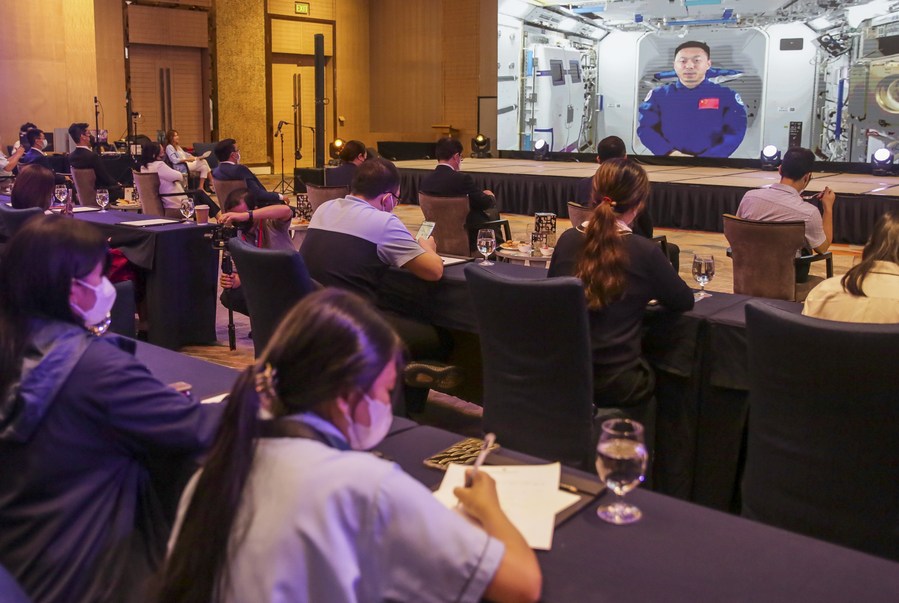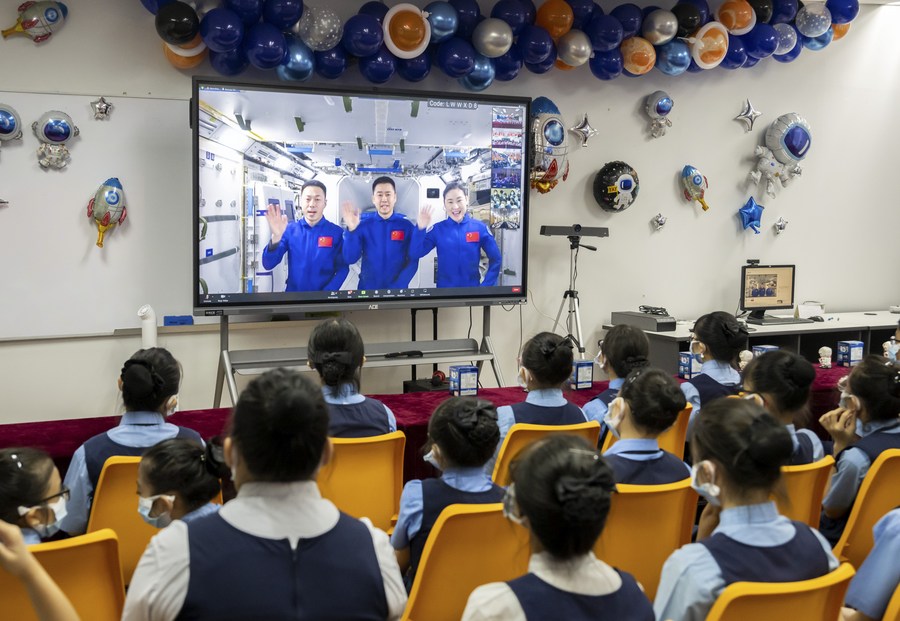Microsatellite launch device.



This is what "SOFT POWER" is all ABOUT.More and More
In the event of "Talk with Taikonauts" via video link, Jeanel Dimayuga, a Philippine high schooler, had a chance to ask Chinese taikonauts working at China's Tiangong space station how they felt the time passing in outer space and the physical impact of a zero-gravity environment.
MANILA, Nov. 2 (Xinhua) -- Hundreds of students across Southeast Asian countries attended Tuesday a live class delivered from China's space station and talked with Chinese taikonauts via video link, which inspired them to pursue their space dream.
Although it was a holiday, scores of Philippine students from high schools gathered for a special session named "Talk With Taikonauts," a unique opportunity for young space enthusiasts from the 10-country bloc Association of Southeast Asian Nations (ASEAN) to have first-hand knowledge about space science and outer space exploration.
Jeanel Dimayuga, a 12th grader from Makati High School, had a chance to ask China's Shenzhou-14 spaceship crew members Chen Dong, Liu Yang, and Cai Xuzhe how they felt the time passing in outer space and the impact of the zero-gravity environment on their bodies.

Students in Taguig city, the Philippines, participate in the "Talk with Taikonauts" event to interact with Chinese taikonauts working at China's Tiangong space station via video link, Nov. 1, 2022
The trio of taikonauts answered various questions from the students and shared with the Asian youth their life and scientific work in the space station since early June when the Shenzhou-14 spaceship was successfully launched.
One day earlier, China launched the 17.88-meter-long space lab module Mengtian, bringing the construction of the space station Tiangong into the final stage. The building of Tiangong into a national space laboratory with three modules marks a milestone in China's three-decade effort to advance its manned space program.
Richard Shao from Philippine Cultural College said China having made such achievements in space technologies has inspired him to continue exploring the mysteries of the universe.
During the live lecture, Philippine First Lady Louise Araneta-Marcos said the dialogue with Chinese taikonauts provided "an opportunity for our younger generation to learn more about space engineering."
"We hope this exchange will further stimulate the curiosity of our Philippine youth regarding space and the bigger frontier out there," she added.
Philippine Space Agency deputy director general Gay Jane Perez hailed China's advancement in space and highlighted China's contribution to sharing and promoting space technologies.
"Young minds are curious and imaginative, and the space offers limitless possibility of pushing the boundary of knowledge, exploring the unknown and creating new technologies and innovations," Perez said.
She said China has created opportunities for cooperation in the ASEAN region. The space lecture would be an "inspiration to our students to pursue their dreams, to explore the vastness of the space."

Students in Kuala Lumpur, Malaysia, participate in the "Talk with Taikonauts" event to interact with Chinese taikonauts working at China's Tiangong space station via video link, Nov. 1, 202
Chinese Ambassador to the Philippines Huang Xilian said outer space is the "common wealth of humanity" and should be explored, developed, and utilized peacefully.
"China advocates for joint efforts with nations around the world to build a community with a shared future for humanity and to enhance international exchange and cooperation in outer space on the basis of equality, mutual benefit, peaceful use, and inclusive development," the Chinese envoy said.
He added that China is willing to share the achievements of aerospace development with the Philippines in various forms and discuss strengthening exchanges and cooperation in the field of aerospace science and technology for the power of science and technology to benefit the people of both countries.



Even a 4-segment SRB that's capable of 2,000t thrust that can run on 600t of solid fuel would already be more efficient than the SLS SSSRB which requires 730t of solid fuel to produce 1,800t of thrust.
If that's the case then simply scaling up CZ-11's P35 motor from its 35t fuel mass/120t thrust config would've produced even greater thrust than this 150t model without even accounting for the weight savings from its carbon fibre hull (which is irrelevant anyway), and it certainly wouldn't have taken them until now (or rather last year to be specific) to manage to produce a 500t thrust SRM.
